Pistol Holster Butt Ideal Holster-Stock (USA)
The idea of a single device that performs the functions of a holster and a removable butt for a pistol, appeared at the end of the 19th century, and at the same time a number of similar structures were proposed. Some of them reached mass production, and even went into service with the armies, while others remained in stories as technical curiosities. One of the enthusiasts involved in the development of the original idea was the American gunsmith Ross M.J. Phillips. At the very beginning of the 20th century, he proposed a new holster-butt, which was distinguished by an interesting design.
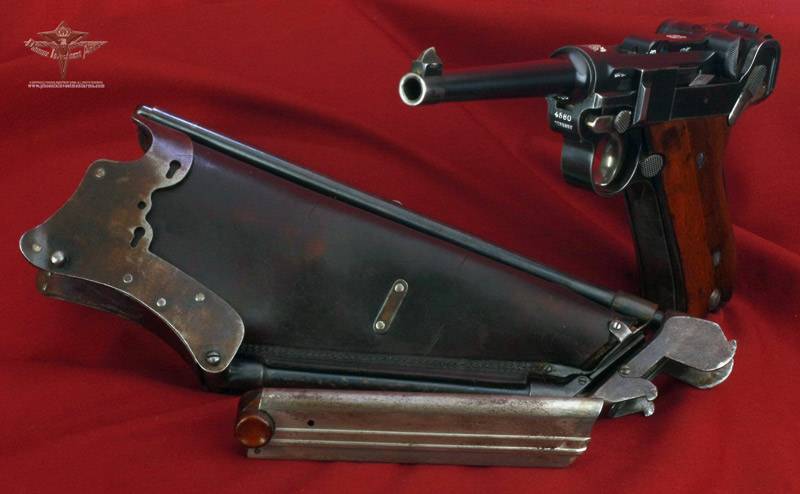
Pistol "Parabellum" and holster-butt Ideal (folded). Photo Phoenixinvestmentarms.com
The design of a new accessory for pistols was created in 1900-1901's. In early September, 1901, R. Phillips sent patent applications for his invention. Soon he received patents from the USA, Great Britain and Germany. At the same time, different designs were described in different documents. Thus, British and German patents were granted on a removable butt of fixed length. The US patent, in turn, concerned a more interesting design with a variable length for transportation.
After obtaining patents for his inventions, R. Phillips launched the production of holster butts for sale. Their manufacture was to be carried out by the own company of the inventor called Ideal Holster Company - “Ideal holsters”. However, only one version of the holster-butt, named for the manufacturer, went into the series. In this case, it was planned to ensure compatibility with different types of weapons on the market.
For compatibility with the “Ideal” holster butt, the gun needed some work. Instead of the standard grip handles, it was proposed to install new products of a similar purpose. Such lining consisted of an inner metal plate and an outer wooden part. In the back of the plate provided a pair of figured cuts. Butt hooks should have interacted with them.
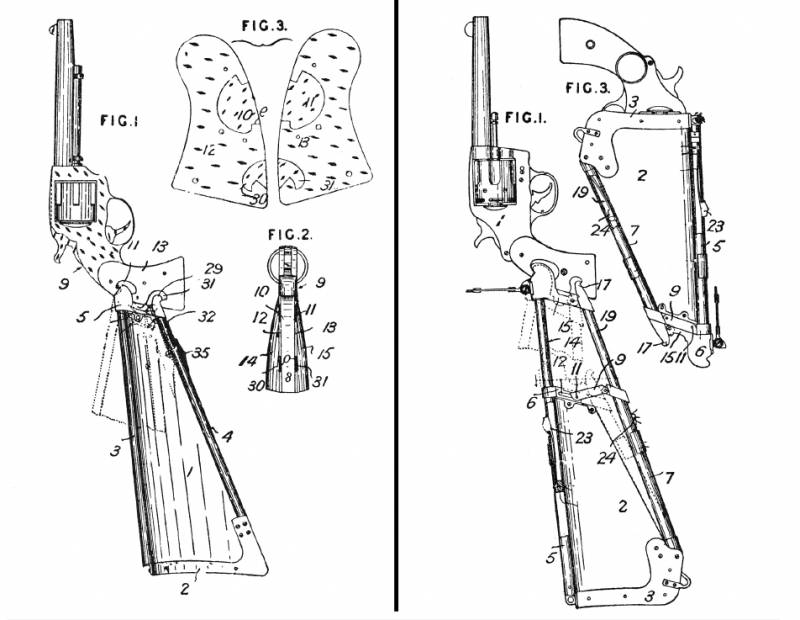
Two variants of butts described in a German patent. Drawing from the book "The Borchardt & Luger Automatic Pistols"
In US patent, a lining design was described for a revolver or pistol of an existing model. At the same time, linings and butts for Parabellum pistols went into a relatively large series. The serial plates differed from those presented in the patent only in the shape and location of the holes for the screws and the cutouts for the hooks.
The patents described a simplified design of a fixed-length holster. In this case, a metal plate was used as the butt plate, which also served as the entrance to the holster. In the lateral projection, it was L-shaped, in the frontal one, it was U-shaped. A pair of tubes of the required length, which were longitudinal force elements of the structure, were fastened to the plate at different angles from the front. A simple system in the form of articulated hooks directed in different directions was placed on the tubes in front. Hooks had a U-shaped in terms of shape. Inside the trapezium formed by the parts of the butt, fit the leather holster of the required dimensions.
To install such a butt on the weapon, it was necessary to compress the tubes and bring the front parts of the longitudinal tubes closer together, as a result of which the front hooks moved in a vertical plane and approached. Then they could be placed in the cutouts of the pistol grip plates: U-shaped plates with hooks in the plan covered the handle itself. After letting go of the tube, the shooter allowed the structure to straighten up, as a result of which the hooks diverged up and down, engaging with the gun linings.
The second version of “Ideal”, later put into the series, was more complex, due to which new opportunities were achieved. Unlike the first, this holster-butt-butt reduced its length when folded. As a result, the product was very convenient. A pistol in such a holster was easier to transport, and an increased butt length improved the shooting results.
The largest elements of the butt holster were again a curved plate butt plate and a leather “bag” for placing the gun. Other details were similar to those used in the first version of the product, but had the most significant differences. The longitudinal tubes were reworked, and the hook system now included several levers.
Instead of simple fixed-length tubes, telescopic devices were used in the butt of the second version. On top of the back plate, a tube of larger diameter was rigidly attached, within which the second, smaller one, moved freely. Inside the tubes there was a simple latch on the basis of a leaf spring, which ensured the fixation of the devices in the transport or working position. The second set of telescopic tubes did not have a latch and was hinged on the bottom of the butt pad.
In front of the larger tubes, near the bottom of the holster, there were clamps with levers that ensured the correct interaction of telescopic devices. In addition, they were stops and limited the course of the internal tubes.
At the front ends of the movable tubes were placed two main parts for mounting the butt on the weapon. On the upper tube was a large detail of the L-shaped profile with a pair of hooks on top. The bottom tube carried a more compact piece with a pair of hooks on the sides. These parts were connected using a small plate mounted on hinges. Due to this design, the mutual position of the hooks was changed in accordance with the movements of the telescopic tubes.
The patent also proposed to equip the new butt with an additional sight. On the upper hook was provided a groove for mounting a mechanical sight with a raised bar. He had to duplicate his own sights of the pistol, simplifying aiming and shooting.
Installing an Ideal Holster-Stock holster butt on a weapon was not particularly difficult. The arrow was asked to place the upper hooks of the butt in the corresponding slots of the piston linings and hook them to the upper edge of the latter. By turning the butt down and forward, the lower hooks were placed in their grooves. Then it was necessary to press the protruding part of the latch inside the tubes and pull the butt plate back.
The butt plate pulled behind the rear tubes of the telescopic devices, while the front ones remained in place, held by hooks. When folding the butt, the hinged lower tubes shifted: the angle between a pair of telescopic devices decreased. At the same time, the lower hooks at the expense of a system of levers shifted down and rigidly fixed inside the lining of the gun.
In the working position, the Ideal butt-holster was a fairly rigid structure, firmly tied to the gun. At the same time the product was quite light and easy to use. Translation from one position to another did not require much effort and took minimal time. A product with such qualities had a chance to find its place in the market.
In the mid-nineties, Ideal Holster, founded by R. Phillips, launched mass production of telescopic holster butts for mass-produced weapons. The self-loading pistol Parabellum P.04 Navy was chosen as the “carrier” of such devices. However, full compatibility was also ensured with other modifications of the Parabellum, which had a similar configuration of the handle and its linings, as well as close trunk length.

Holster, top view. Photo Phoenixinvestmentarms.com
Before the start of mass production, the developed design has undergone some changes. Thus, serial butts received a plate-butcher plate of a very complex shape. In its side parts there were cutouts for the protruding parts of the gun. The lower element of the plate was distinguished by a large length and ensured comfortable handling of the pistol grip in a holster. Directly to the plate and the top tube was attached leather holster, the dimensions of which corresponded to the selected gun.
Due to the alteration of the butt plate, the length of the lower telescopic tubes was reduced. They removed the clamps with levers, instead of which are now present simple plates for mounting holsters. Also, the designers simplified the design of the front hooks by removing the intermediate plate. The two hook parts were now directly connected to each other, although their mobility and function remained the same.
It was suggested to carry the holster on the belt with a large clip-clips. A large-sized metal part was mounted on a plate butt plate. It was fastened with a pair of pins and shaped holes on the plate and a small loop on the leather holster. For greater user convenience, the clamp is executed removable. It can be installed on the right or left side of the holster.
The Ideal Holster-Stock holster-butt for the Parabellum pistol when folded had a length of less than 250 mm. In the working position, the length was increased by about 100 mm, providing sufficient ease of shooting. There is information about the creation of a holster for pistols with longer trunks, different in other dimensions. The mass of the product, according to available data, did not exceed 500-600 g. Thus, the “ideal” butt had serious advantages over existing counterparts made of wood.

Gun with butt spread out. Photo of Landofborchardt.com
Two versions of the butt design were described in patents, in theory compatible with different types of weapons. Nevertheless, as far as is known, only a foldable holster-butt went into the series and only under Parabellum. In the future, there was a modification of such a product for other types of weapons. So, it is known about the production of a small batch of holsters with overlays for the handle of revolvers Colt.
Serial production of a folding telescopic holster butt for a Parabellum pistol began in the middle of the first decade of the 20th century. The own factory of R. Phillips Ideal Holster Company worked in the city of Toledo (pieces of Ohio). According to known data, the United States arms community, as often happens, took the novelty with enthusiasm. Potential buyers were interested in the original device and ordered it. At the same time, the manufacturing company failed to receive orders from government agencies. By then, the Parabellum pistol version of the .45 ACP cartridge had arrived at the US Army, but the command did not wish to order special accessories for this weapon. Modification holsters for revolvers, too, was not interested in the army.
It should be noted that in addition to the “Ideal” butt, some other developments of the same purpose were present in the market, first of all, the simplest wooden devices. The product of Ideal Holster had certain advantages over them, but it was not without flaws. So, because of the greater complexity of the design, the folding stock was more expensive. In addition, during the operation could have these or other problems with the mechanisms. Finally, the holster-butts market was not infinite, which led to increased competition.
According to known data, until the end of the ninetieth years, the company RMJ. Phillips managed to release no more than a few hundred holsters-butts of her design. These products went shopping, and a significant part of them was sold out. However, at a certain point, sales dropped sharply, with the result that the manufacturing company was left without new orders. The most interesting product with limited commercial potential had to be removed from production. In addition, the inventor no longer planned to refine and launch other stock options in the series.
Almost all the manufactured holsters for "Parabellum" were sold and used by civilian riflemen. Over time, such devices changed owners, broke down or simply thrown away as useless. However, a certain number of original butts still exist. Now they represent a well-known collection value. Products of the company Ideal Holster regularly appears on foreign gun auctions and attracts the attention of buyers. Rare enough products get a decent score. Not so long ago, R. Phillips's butt-holster was auctioned off for 4 with more than a thousand US dollars.
At the time of its appearance, the removable telescopic holster-butt of R. Phillips' design attracted limited public attention, although it was sold, in general, not bad. Nevertheless, a number of factors limited its real commercial potential, which was soon fully realized - however, with the saddest consequences for the project. Production had to be curtailed due to the lack of new orders. Over time, the telescopic holster-butt went into the category of historical values. A very interesting and in some way even a beautiful solution of an engineering problem naturally attracts collectors and deservedly occupies a place in the history of accessories for small arms.
Based on:
http://forgottenweapons.com/
http://phoenixinvestmentarms.com/
http://landofborchardt.com/
http://luger.gunboards.com/
https://investmentsinarms.com/
https://patents.google.com/patent/US762862A/en
Görtz J. Strugess G. The Borchardt & Luger Automatic Pistols. - Galesburg IL USA Simpson Production, 2012.
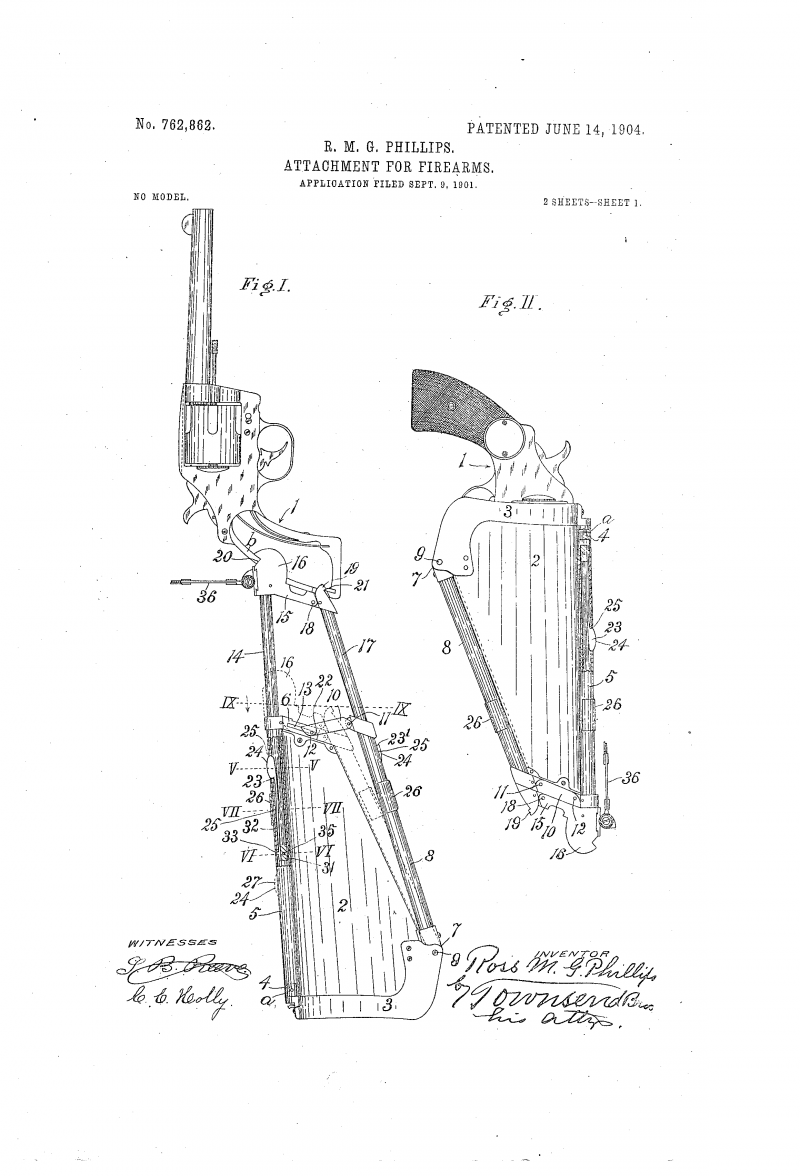
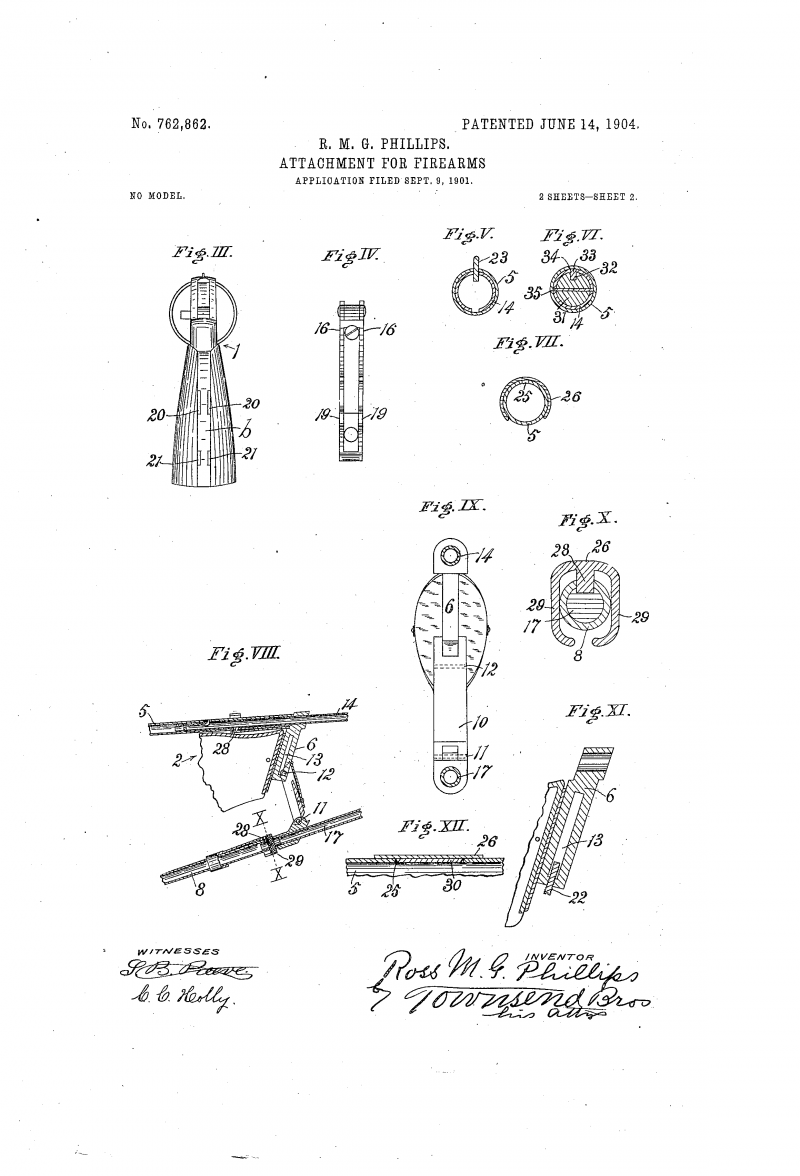
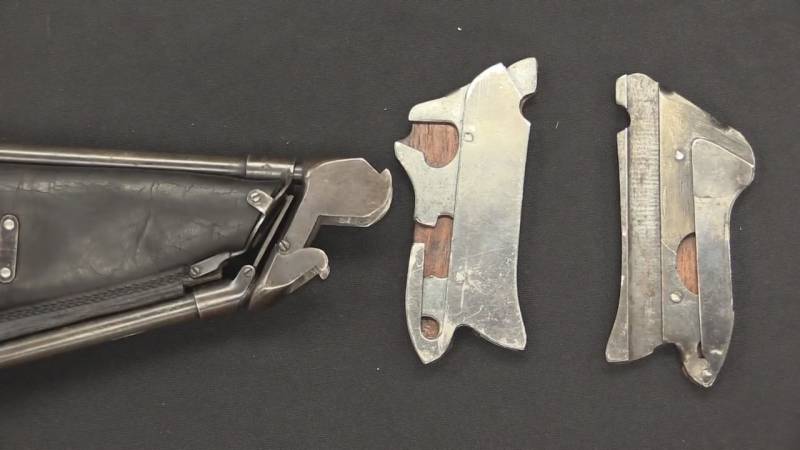
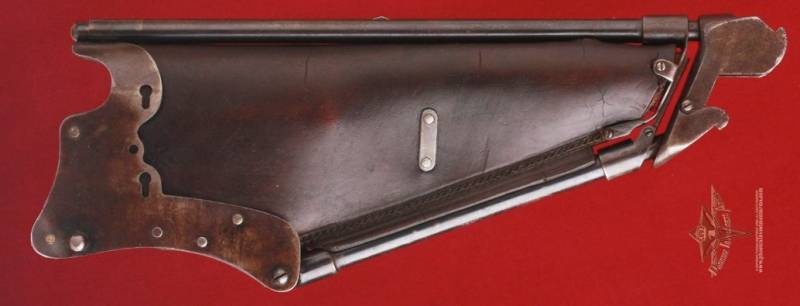
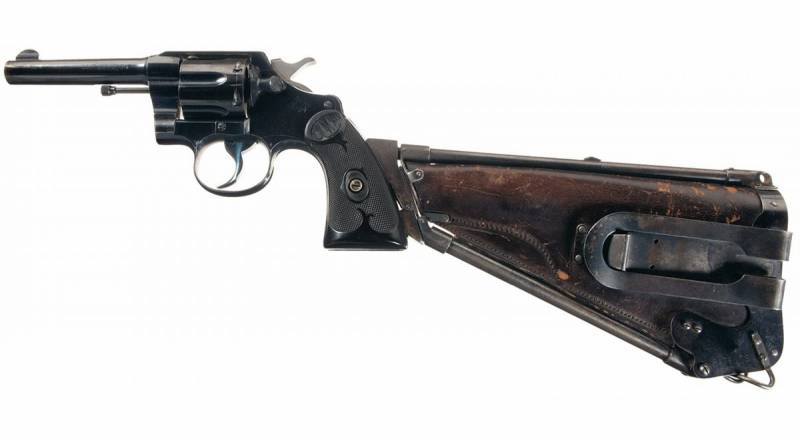
Information